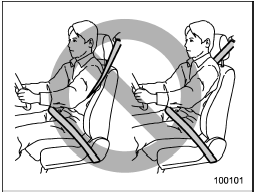Fastening the seatbelt

Х Never use a belt that is twisted or reversed. In an accident, this can increase the risk or severity of injury.
Х Keep the lap belt as low as possible on your hips. In a collision, this spreads the force of the lap belt over stronger hip bones instead of across the weaker abdomen.
Х Seatbelts provide maximum restraint when the occupant sits well back and upright in the seat.
To reduce the risk of sliding under the seatbelt in a collision, the front seatbacks should be always used in the upright position while the vehicle is running.
If the front seatbacks are not used in the upright position in a collision, the risk of sliding under the lap belt and of the lap belt sliding up over the abdomen will increase, and both can result in serious internal injury or death.
Х Do not put cushions or any other materials between occupants and seatbacks or seat cushions.
If you do so, the risk of sliding under the lap belt and of the lap belt sliding up over the abdomen will increase, and both can result in serious internal injury or death.


Never place the shoulder belt under the arm or behind the back. If an accident occurs, this can increase the risk or severity of injury.

Metallic parts of the seatbelt can become very hot in a vehicle that has been closed up in sunny weather; they could burn an occupant. Do not touch such hot parts until they cool.
See also:
Forward direction
Turn the УTUNE/TRACK/CHФ dial clockwise to skip to the beginning of the next
track/file (track). Each time the dial is turned, the indicated track/file (track)
number will increase.
NOTE
In an ...
Refrigerant for your climate control system
Your air conditioner uses ozone friendly refrigerant HFC134a. Therefore, the
method of adding, changing or checking the refrigerant is different from the method
for CFC12 (freon). Consult your SUB ...
Air inlet selection button
Air inlet selection button
ON position (recirculation): Interior air is recirculated inside the vehicle. Push the air inlet selection button to the ON position.
The indicator light will illuminate.
...


